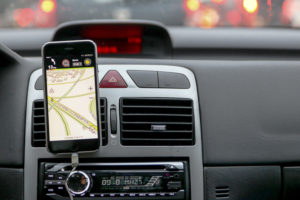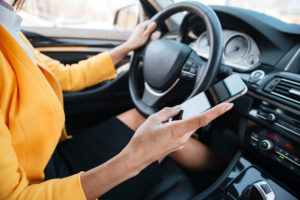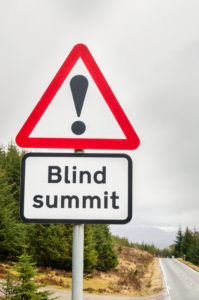How to use a sat nav safely
Sat Navs are a brilliant tool used every day to help people get from A to B. Without the need for an expert map reader in their front passenger seat. There is one problem, they are not entirely safe to operate, especially if you are behind the wheel of a car. In this article, we will take you through the steps of how to use sat navs safely.
The AA also have a 10 step safety check for using a Sat Nav.
What type of Sat Nav?
Built in
If your car has a built in sat nav system then you have found yourself with one of the safest systems around. The integration of sat nav into a car infotainment system means that it has been designed for ease of use whilst behind the wheel. The beauty of an infotainment system is that all of the operating functions such as buttons or touch screen have been designed to be within easy reach and reduce the amount of time spent with your eyes off of the road. Some systems even boast on-wheel buttons so you don’t even need to take your hands off the wheel.
Free standing sat nav
If you have a free standing sat nav unit then you first of all must ensure the unit is secure. Most sat nav systems will include a mount to attach it to the car dashboard or windscreen. This uses a sucker system which glues itself to a surface and is released with the flick of a switch. These can be temperamental so ensure it is stuck fast to avoid your sat nav crashing dramatically into the footwell, or worse out of an open window as you turn a sharp corner. Then, attach the unit to the mount. Again, check it is securely fitted.
Compare free standing sat navs with these reviews
 Perhaps your sat nav is on your mobile phone. In this instance, you can purchase a mount for the phone to be housed within while in sat nav mode. It is equally important to ensure your phone mount is secure before you embark on your journey. We recommend you use a mount to house your phone if you are using it as a sat nav in the interest of safety. Having the phone on your lap or the passenger seat next to you will force you to take your eyes off of the road. Having it at eye level will help to minimise your risk of accidents.
Perhaps your sat nav is on your mobile phone. In this instance, you can purchase a mount for the phone to be housed within while in sat nav mode. It is equally important to ensure your phone mount is secure before you embark on your journey. We recommend you use a mount to house your phone if you are using it as a sat nav in the interest of safety. Having the phone on your lap or the passenger seat next to you will force you to take your eyes off of the road. Having it at eye level will help to minimise your risk of accidents.
If you’re using your phone as a sat nav I would also recommend switching your phone to do not disturb so that you are not distracted by incoming emails or messages.
A tutorial for I phone users on how to enable to do not disturb function.
Before you set off
 Before you even turn on the engine I’d suggest planning your route into the system. Most of these navigation systems work on finding your desired location by postcode. If you don’t know the postcode of your destination you can also search by street name. It would be worthwhile at this stage taking a look over the overall route. Just in case your system fails mid-way through. Double check that any mounts are secured safely and begin.
Before you even turn on the engine I’d suggest planning your route into the system. Most of these navigation systems work on finding your desired location by postcode. If you don’t know the postcode of your destination you can also search by street name. It would be worthwhile at this stage taking a look over the overall route. Just in case your system fails mid-way through. Double check that any mounts are secured safely and begin.
Check the volume and visibility of your sat nav before you set off to ensure you don’t have to play around with the system while on the open road. You should be able to easily hear and see your sat nav.
Choosing a suitable position
This is down to your discretion and there isn’t a specific right or wrong way of locating your sat nav on the dash or windscreen. Obviously locating it where it could obstruct the view of the driver is a no go. Here are a few considerations you can make when deciding where to locate your sat nav system
Considerations when choosing the best place for your satnav
- If fitted to the windscreen, it should be low down to minimise the intrusion into the driver’s field of view
- Consider placing it in the lower right corner of the windscreen to minimise obstruction to the driver’s vision
- Alternatively, if this is not possible, it may be acceptable to place the unit low down in the centre of the windscreen, providing the design of the sat-nav mounting and the vehicle and your seating position permits this
- Do not locate units where they may cause injury in a crash. This includes potential head strike zones or on the windscreen or other location where a deploying airbag may contact them. Where a passenger airbag is fitted, this includes anywhere to the left of centre of the windscreen
- High up on the windscreen should be avoided as this will often interfere with rear view mirrors and sun visors and result in the power cord trailing across the driver’s vision area
- Consider the location of power leads to avoid the possibility of them interfering with or becoming entangled in vehicle controls
- Avoid covering or restricting access to dash instruments and controls as far as possible.
During the journey
You’re ready and prepped for the open road. Now, there shouldn’t be any need for you to touch the unit again until you reach your destination. Except to perhaps accept an alternative route suggestion or adjust the volume. Avoid the temptation in a rush to start driving first and programme the sat-nav on the route. Any prolonged period of time spent looking away from the road is a hazard. So always set the unit up fully before even starting the engine.
Road signs
 Pay attention to road signs. The satnav will inform you of the route and the locations of upcoming speed cameras. Great for the purpose, but not conclusive or replacing your need to be vigilant while behind the wheel. The road signs are there to inform you of potential hazards. If you’re approaching a blind bend above the speed limit you could encounter a deer or obstruction in the road and disaster could strike.
Pay attention to road signs. The satnav will inform you of the route and the locations of upcoming speed cameras. Great for the purpose, but not conclusive or replacing your need to be vigilant while behind the wheel. The road signs are there to inform you of potential hazards. If you’re approaching a blind bend above the speed limit you could encounter a deer or obstruction in the road and disaster could strike.
Similarly, just because your sat nav is telling you to turn right into the next road, that doesn’t always mean you should follow these instructions.The road could very well be a one-way street and your sat nav, may not be aware of this and try sending you through it the wrong way. While these instances are few and far between you can’t be too careful and must always check the road signs before manoeuvring to follow the instructions of your sat nav.
In a larger vehicle with sat nav?
Your sat nav will not know that you have switched your trendy city runaround for a minivan. Therefore it is your responsibility to make a judgement on if the roads are suitable or not for your vehicle to drive down.
The main takeaway safety tip for using a satnav is to never operate it unless the car is parked up.This includes temporarily adjusting the volume on route while stopped at traffic lights, for example.
